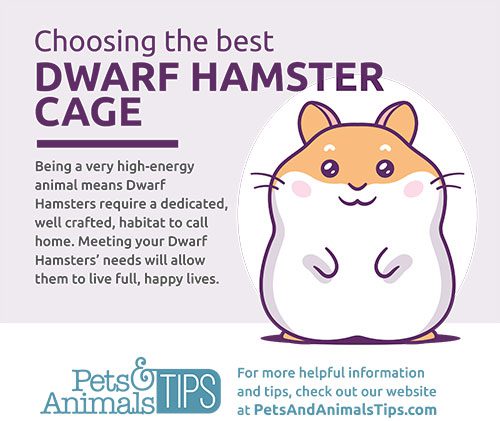Many popular pet stores have shelves upon shelves of cages labeled for hamsters; however, not all of these cages are really big enough to house any hamster, including dwarf hamsters. Not only that, but a lot of hamster owners wonder whether wire or glass cages are the best cages for a dwarf hamster.
Dwarf hamsters are one of the smallest hamster breeds in the world, but they are very high-energy animals and require a more involved hamster habitat than you might think. If you are considering getting a dwarf hamster, or if you already have one without a proper cage setup, consider the size, contents and location of the cages these hamsters need.
The Best Dwarf Hamster Cage Size

Dwarf hamsters, despite their small size, need to be kept in a fairly large cage, usually at a minimum of 30 gallons. Up to four hamsters may be kept in a cage of this size; however, more hamsters than four will require more space, specifically with horizontal floor space. No matter how many hamsters you plan on keeping in your dwarf hamster cage though, remember that bigger is always better, and there is no maximum cage size for dwarf hamsters.
While 30 gallons can translate to different length, width and height cage proportions, you should aim to have more floor space than height space. One base minimum floor size you can go by is 25 inches by 18 inches. When it comes to vertical space, dwarf hamsters don’t need much, so there is no minimum requirement, but you can take advantage of tall cages by adding some climbing equipment for your furry friends.
The Best Types of Dwarf Hamster Cages
While there is some debate on whether wire or glass cages are best for dwarf hamsters, pet owners should know that both types work fine. However, anyone who opts for a wire cage should also know that these cages require adding a plastic bottom or tray to avoid hamster injuries, since the paws of dwarf hamsters can get easily trapped in wire bottoms.
Glass cages, or aquarium tanks, provide great insulation and protection from drafts in chilly rooms. On the other hand, these tanks do not provide as much ventilation or great air quality as wire cages because they have little, to no holes, in their sides. Glass tanks can also be subject to condensation in areas of high humidity. When deciding which type of cage will work best for your hamster, consider factors like the air temperature and quality of the room where you plan to keep your hamster.
What To Include in a Dwarf Hamster Habitat
Bedding
Digging and burrowing are favorite pastimes for all types of hamsters, so it is vital that you include a thick layer of bedding at the bottom of your hamster’s cage. A minimum of a one-quarter inch of bedding is recommended to cover a cage’s floor, and you can use commercial bedding, sawdust shavings or potting soil as your hamster’s bedding.
Gnawing Pieces
All hamsters need something to chew on constantly to keep their teeth healthy. In a cage for dwarf hamsters, there should be things like commercial gnawing blocks or untreated wood chunks, like natural wood branches, available to the hamsters at all times.
Climbing and Interactive Pieces

Silje Roseneng on Unsplash
As mentioned above, dwarf hamsters are active by nature, so they require a lot of pieces where they can play and exercise. Consider adding climbing equipment and wheels to your hamster’s habitat for them to use and enjoy. You can buy toys or play equipment for hamsters, or you can make your own; some hamsters even enjoy playing in empty, small cardboard boxes.
If you’d like to add new interactive pieces to your hamster’s existing cage, do so with one piece at a time and add no more than one new piece a week. Dwarf hamsters become stressed with big changes, so it’s best to let them adjust slowly to new things, whether it be a new toy or a new type of food.
Nest Boxes
Dwarf hamsters sleep between 12 to 14 hours a day, and they only like to sleep in hidden areas where they can feel secure. You should provide a nesting box for each hamster you own. You can either purchase or make these yourself. To make a nesting box, create a small box out of cardboard, wood or plastic and fill it with cotton-based bedding material. For this material, you can use shredded napkins or old pieces of cloth.
Food Dishes and Water Bottles
Dwarf hamsters should be fed a tablespoon of dry food daily in a small, metal or plastic dish that you keep in their cage. They should also be given access to clean water at all times, and the easiest way to supply this is with a water bottle that attaches to the side of their cage. Water bottles also usually come with markings that allow you to monitor how much your hamsters are drinking each day. However, if you keep your hamsters in a glass cage, you may not have anything to wrap a water bottle to, so you can consider using a water dish or water dispenser that sits on the ground instead.
Where To Place a Dwarf Hamster’s Home
Dwarf hamsters like a temperature between 65 and 75 degrees Fahrenheit with no drafts around them. A cage for a dwarf hamster should therefore be placed in a room that meets this temperature range around the clock. The room should also be relatively quiet in order to avoid putting stress on the hamster. In this room, you should try to put your hamster’s cage high and out of reach of other pets, like dogs. However, you should also be sure to secure any large holes or gaps in the cage that your hamster could slip through to avoid letting your hamster escape and fall.





